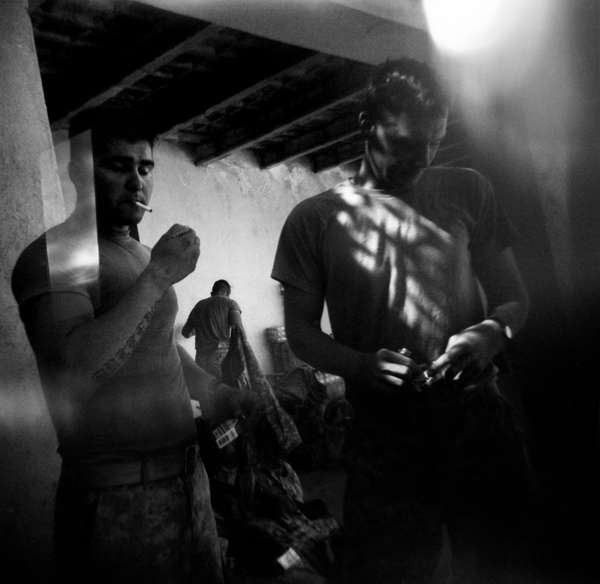 Time for a small update about my work. After a month long exhibition 'Behind the Curtain' has been recently taken down from the wall of Balucka Gallery in Lodz, Poland. Here is a nicely designed brochure and a interesting review about my project.
Time for a small update about my work. After a month long exhibition 'Behind the Curtain' has been recently taken down from the wall of Balucka Gallery in Lodz, Poland. Here is a nicely designed brochure and a interesting review about my project.Ula Wiznerowicz: Images from Behind the Curtain
Behind the Curtain is the title of a cycle of photographs that
Ula Wiznerowicz has carried from the world of her family and childhood into a
vision of painful, incurable modernity. Wiznerowicz tenderly unmasks a world of
people convinced that they cannot be seen. It is a major problem not only in
Greater Poland but in countless other places.
She has written about her
own exhibition: ‘Forgotten and useless things covered in dust, emaciated cats
running around searching for leftovers, rooms taken over by spider webs and a
strong odour of alcohol. This was merely a part of the chaos that I encountered
while photographing my native village, Palmowo and the surrounding areas in
Poland where I grew up.The series of photographs represents a personal journey
through individual stories of the men and women dealing with alcoholism. Not
all the characters are necessarily alcoholic, but everyone has been affected by
alcoholism, through family or friendship.’
A dirty glass balanced on an old chair, a filthy, overflowing ashtray, a
TV remote control, a cigarette lighter and an alarm clock: these objects form
part of the composition of one of the photographs, the attributes of a human
world which are the subject of Wiznerowicz's creative gaze. It is an image of
squalor and sorrow, an image of helplessness, of losing oneself in lost
memories. A conclusion of sorts: a closed composition.
The value of this exhibition is manifold. The motivation behind it
(rather than the inspiration?) was concern for humanity with all its beauty and
ugliness and an intelligent desire to find one's own roots.
Besides a handful of landscapes which depict the milieu in which the
subjects of the photographs spend their daily lives, the photographs of
Wiznerowicz frame people, some in portraits from which there is no escape,
others showing objects, still
warm, only recently touched, or left to go cold as life no longer allows their
owners to tidy them up.
As a photographer Wiznerowicz doesn't take pictures from the front row,
she rejects her privileges, free passes to an unfamiliar world. She feels the
chill of the stage along with the actors, touches the props but doesn't move
them, doesn't interfere, doesn't impose. She tries to gently knit her presence
into the tattered hair of these difficult human stories. She looks and
immortalises. The faces and objects say all there is to say.
Almost every image carries a commentary, words penned by the photographer
herself (‘I got used to the piles of junk and clothes scattered
around the flat, the dirt and the horrible smell. It was quite dark, the room
was engulfed in clouds of cigarette smoke. Cats were running from corner to
corner, like crazy, trying to find something to eat. But nobody took any notice
and nobody was bothered that I was there, as they opened another bottle of
vodka.’) or one of the characters
(‘When there's no alcohol to pass around your friends
don't come round. It's hard then.’) They are not forceful or intrusive, they merely confirm our intuitions
and add to the stories told by the images.
These days it is easy to
take photographs – everyone can do it and that's the problem. What is
captivating about the work of Ula Wiznerowicz is a lack of engagement with
technology, an honest tolerance of imperfection whenever it appears. This is a
cautious approach to photography, observant of the limits of good compositional
taste but also of the right of objects to exist in the frame. The faces of the
subjects of this sorry tale have not had the signs of their difficult
experiences edited out, Wiznerowicz does not taint them with fakery. Her tweaking of colour and dynamics is
justified by the narrative: a bright, optimistic window with a lamp and some
fruit on a windowsill. The caption contains the words ‘I died and at 50 years old was resurrected from the dead.’, which justify the bright light. Those who
speak openly about themselves have brightened, sharpened features. They stare
into the light or the darkness depending on their outlook on the future. The portrayal
of cats is exceptional; because they are constantly moving, chasing after food,
the photographer lets them blur, allowing them a feline individualism.
And so in the same way that a single strand of DNA captures a unique
human form and the shape of the body and how it speaks tells a trained eye of its
condition, every photograph in the cycle Behind
the curtain is a closed narrative world capable of transparently
corresponding to the image hanging beside it. An honest cycle, a tale.
By Jola Sowińska-Gogacz, Translation by: Greg Goodale























+copy.jpg)










.jpg)